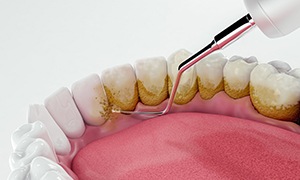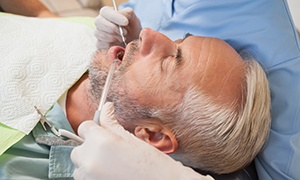Gum Disease Treatment – Metairie, LA
Restoring Your Smile & Boosting Your Oral Health

The moment you notice that your gums are bleeding, swollen, or red, you should call to schedule an appointment with our team at Second Line Family Dentistry. What is commonly referred to as gingivitis – the earliest stage of gum disease – can quickly progress into what is known as periodontitis. Without timely treatment, you can experience more serious dental issues. Fortunately, we provide safe treatment options that are designed to restore your smile and boost your oral health. Don’t wait to seek help; instead, call our office today to inquire about gum disease treatment that is right for you.
What is Gum Disease?

Gum disease is a common oral health problem that occurs when bacteria attack the soft oral tissues located inside the mouth. It directly affects the bones and gums, causing teeth to be at risk.
Gingivitis is considered the earliest stage of gum disease, resulting in bleeding and inflamed tissues; however, these symptoms can be reversed with regular oral hygiene at home and frequent professional cleanings. If allowed to progress, though, it can become periodontitis, which is a more advanced form of gum disease. This stage can be managed but not cured.
Tooth and bone loss are the two greater concerns associated with gum disease, which is why immediate care is required.
Those who are most likely to develop gum disease include:
- Those who smoke or use tobacco
- Those with poor oral hygiene
- Genetics
- Those with conditions that can compromise the immune system (i.e., diabetes)
- Individuals who take certain medications that can lead to dry mouth
- Pregnant individuals because of the change in hormones
The Centers for Disease Control and Prevention (CDC) reports that an estimated 47% of adults in the U.S. aged 30 years and older have some form of gum disease. Since it is known to increase with age, nearly 70% of individuals 65 years of age and older have it to some degree.
Symptoms of Gum Disease

Many different symptoms can arise with gum disease, some of which include:
- Red or swollen gums
- Bleeding gums
- Bad breath (halitosis)
- Tender gums
- Gum recession (your teeth appear longer than before)
- Difficulty/pain while chewing
- Loose teeth
- Change in bite
- Increased tooth sensitivity
- Bone or tooth loss
- Change in how your restorations feel
Scaling & Root Planing

Scaling and root planing is also known as deep cleaning and is a two-part process. Scaling involves removing all plaque and tartar from your teeth to reduce the number of bacteria that are present. If your gums are receding, we will continue beyond the gumline to remove additional bacteria from the pockets. Once complete, we’ll move on to root planing, which requires smoothing out the roots of your teeth so that bacteria cannot reattach. Your gums will then be able to connect with your teeth and offer greater protection to the roots.
Learn More
Do You Need Scaling & Root Planing?
Scaling and root planing is sometimes called a “deep cleaning.” Essentially, that’s what it is. When we pick up on early signs of gum disease, like bleeding, swelling, and inflammation, we will try to address it right away to prevent it from progressing and resulting in lasting damage to oral health. The goal of scaling and root planing is to remove bacteria that have accumulated around or beneath the gumline. We also smooth down the roots of the teeth to help the gums reattach and heal more quickly.
The Process of Scaling & Root Planing
Scaling and root planing is comprised of two parts – as the name suggestions. They generally take place over two separate appointments. The first part is called “scaling.” This is when your dental team scrapes away plaque and tartar that accumulates along the gumline using dental instruments. They will also target the area beneath the gumline where bacteria build up.
After the scaling is complete, your dental team will begin the root planing process. They will smooth down sections of the teeth beneath the gumline to help them adhere to your teeth. This will help to speed up the healing process and make it more challenging for the bacteria to build up again. Ultimately, this process reduces your risk of developing gum disease again.
Aftercare Tips for Scaling & Root Planing
Soreness is normal after scaling and root planing. Your gums may also be a little bit inflamed. This is temporary following your treatment and should resolve itself in a few weeks. Here are some tips to speed up your recovery:
- Brush your teeth twice daily using a soft-bristled toothbrush and fluoridated toothpaste. Make sure to use gentle motions.
- Rinse your mouth with salt water after meals to prevent irritation.
- Floss thoroughly every day.
- Stick to a soft diet for the first 48 hours following your treatment.
- Avoid foods that are spicy, acidic, or hot.
- Refrain from intense physical activity after your treatment.
How Do We Treat Gum Disease?

The only way to know which gum disease treatment is right for you is to meet with Dr. Ferguson for a scheduled appointment. She will thoroughly examine your mouth and determine how severe the bacterial infection is. Using the information she compiles, she will go over the various treatment options with you.
Antibiotic Therapy

In combination with scaling and root planing, Dr. Ferguson may also suggest antibiotic therapy. Delivered as a pill, you will take it so that any existing bacteria will be eliminated. It can take time for the medication to disperse and reach the small crevices where plaque and tartar may still be present; however, you can count on the antibiotic to do its job and ensure better gum health in the future.
 Mayda Ferguson, DDS
Mayda Ferguson, DDS
